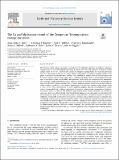The Ca and Mg isotope record of the Cryogenian Trezona carbon isotope excursion
Abstract
The Trezona carbon isotope excursion is recorded on five different continents in platform carbonates deposited prior to the end-Cryogenian Marinoan glaciation (>635 Ma) and represents a change in carbon isotope values of 16–18‰. Based on the spatial and temporal reproducibility, the excursion previously has been interpreted as tracking the carbon isotopic composition of dissolved inorganic carbon in the global ocean before the descent into a snowball Earth. However, in modern restricted shallow marine and freshwater settings, carbon isotope values have a similarly large range, which is mostly independent from open ocean chemistry and instead reflects local processes. In this study, we combine calcium, magnesium, and strontium isotope geochemistry with a numerical model of carbonate diagenesis to disentangle the degree to which the Trezona excursion reflects changes in global seawater chemistry versus local shallow-water platform environments. Our analysis demonstrates that the most extreme carbon isotope values (∼-10‰ versus +10‰) are preserved in former platform aragonite that was neomorphosed to calcite during sediment-buffered conditions and record the primary carbon isotope composition of platform-top surface waters. In contrast, the downturn and recovery of the Trezona excursion are recorded in carbonates that were altered during early fluid-buffered diagenesis and commonly are dolomitized. We also find that the nadir of the Trezona excursion is associated with a fractional increase in siliciclastic sediments, whereas the recovery from the excursion correlates with a relative increase in carbonate. This relationship suggests that the extreme negative isotopic shift in platform aragonite occurred in concert with periods of increased input of siliciclastic sediments, changes in water depth, and possibly nutrients to platform environments. Although the process for generating extremely negative carbon isotope values in Neoproterozoic platform carbonates remains enigmatic, we speculate that these excursions reflect kinetic isotope effects associated with CO2 invasion in platform waters during periods of intense primary productivity.
Citation
Ahm , A-S C , Bjerrum , C J , Hoffman , P F , Macdonald , F A , Maloof , A C , Rose , C V , Strauss , J V & Higgins , J A 2021 , ' The Ca and Mg isotope record of the Cryogenian Trezona carbon isotope excursion ' , Earth and Planetary Science Letters , vol. 568 , 117002 . https://doi.org/10.1016/j.epsl.2021.117002
Publication
Earth and Planetary Science Letters
Status
Peer reviewed
ISSN
0012-821XType
Journal article
Description
This work was supported by a grant from the Simons Foundation (SCOL 611878, ASCA) and the Carlsberg Foundation to ASCA. ASCA and CJB also acknowledge support from the Danish National Research Foundation (Grant No. DNRF53). ACM and CVR acknowledge support from NSF (EAR-0842946) for funding fieldwork on the Trezona Formation in South Australia. JAH acknowledges support from NSF (IES-1410317) and from NSF OCE CAREER Grant (1654571).Collections
Items in the St Andrews Research Repository are protected by copyright, with all rights reserved, unless otherwise indicated.

